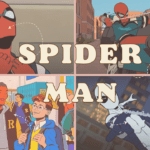In the world of cinema, music is much more than just a background element—it’s the unsung hero of storytelling. From heart-pounding action to tear-jerking moments, soundtracks elevate emotions and create unforgettable scenes. While musicals are celebrated for weaving songs directly into the plot, there’s a special charm in films that aren’t musicals but still let music play a starring role. 🎶
Did you know that some of the most iconic scenes in film history owe their power entirely to the music accompanying them? Think about it: would The Lion King’s opening scene hit as hard without “The Circle of Life“? Or could Titanic have achieved its legendary status without Celine Dion’s “My Heart Will Go On”? Even when the films themselves aren’t considered musicals, music often acts as an emotional guide, shaping how we experience the story.
In this post, we’re spotlighting 6 non-musical films where music takes center stage, proving its power to define tone, enrich characters, and deepen storytelling. From touching coming-of-age dramas to adrenaline-packed thrillers, these movies remind us that music is not just an accessory—it’s a character in its own right. 🎼
Let’s celebrate these cinematic gems that prove you don’t need a “musical” label to make music unforgettable. Ready to explore? 🌟
🎭 Joker (2019)
Few films master the interplay between music and storytelling quite like Joker. 🎻 The haunting soundtrack, composed by Hildur Guðnadóttir, offers an emotional map into the fragmented psyche of Arthur Fleck. With each note, we feel his isolation and slowly escalating madness, allowing the music to act as a mirror for his unraveling mind. The score is chilling, ethereal, and incredibly intimate, wrapping around the film’s dark narrative like a second skin.
One of the most unforgettable moments is the staircase dance scene, where Arthur transforms into the Joker. The dance, set to “Rock and Roll Part 2” by Gary Glitter, is a bold juxtaposition of chaos and freedom. Director Todd Phillips described this sequence as the film’s emotional “catharsis”, saying it was crucial in symbolizing Arthur’s final break from societal constraints.
🗣️“It was the first time in the whole movie that he’s truly alive,“
Phillips said, highlighting how music plays a key role in that transformation.
🎶 Guðnadóttir, whose music won the Academy Award for Best Original Score, worked closely with Phoenix to ensure the soundtrack was tightly interwoven with the actor’s portrayal. She shared in an interview that much of the score was created before filming even began. This allowed Joaquin Phoenix to embody the character with the rhythm of the music already in his head, creating an uncanny synergy between the visual performance and the emotional beats of the soundtrack.
“The music almost dictated where the performance went,“
Phoenix commented.
Here’s a fun fact: the iconic score was almost entirely recorded using cellos, an instrument that Guðnadóttir felt could perfectly capture the film’s underlying tension and sorrow. The deep, mournful tones of the cello were a perfect reflection of Arthur’s inner torment, while also subtly hinting at his eventual, inevitable rebirth into the Joker.
Phillips himself has openly acknowledged the crucial role music played in shaping the film’s tone.
“The score became the heartbeat of the movie,” he said. It’s not just a soundtrack-it’s a narrative device, one that guides the emotional journey of the audience, heightening both the tension and the release.
Beyond its technical brilliance, Joker also resonates on a deeper cultural level, reflecting the growing sense of alienation in contemporary society. The film’s soundtrack, combined with its stark cinematography and haunting performance by Phoenix, helps emphasize the film’s themes of societal breakdown and personal chaos.
🎥 Joker is a perfect example of how music can transcend the traditional role of a soundtrack, transforming into a character of its own. If you haven’t yet experienced this film in all its sonic glory, be sure to check it out on Max-you’ll never hear film music the same way again. 🌟
🎮 Scott Pilgrim vs. The World (2010)
Directed by Edgar Wright, Scott Pilgrim vs. The World is a unique approach to music that sets it apart from typical films, even though it’s not a traditional musical. The story centers around Scott Pilgrim, a young man battling his love interest’s seven evil exes-but it’s the soundtrack that truly drives the narrative. From epic fight scenes to intimate moments, every beat, riff, and chord strikes a perfect balance, amplifying the film’s quirky, fast-paced energy. 🎸
Much of the film’s rhythm comes from its original songs, crafted by Beck, whose music captures the anarchic spirit of the film. Wright, a director known for his musical sensibilities, carefully curated the soundtrack, selecting songs that reflect the emotional tone of the scenes while infusing the movie with a pulsating energy that feels almost like a rock opera. According to Wright.
“The music is almost like the character of the film. It drives it, creates the tempo, and gives the audience a sense of the mood.“ 🎶
One memorable scene, where Scott faces off against one of the exes in an epic battle of the bands, perfectly demonstrates the fusion of music and action. Wright emphasized that the music’s presence in these fight scenes wasn’t just about pumping up the action-it’s also about building character.
“Each ex has their own musical genre and their own fight scene,“
Wright explained, highlighting how the film used genre-specific soundtracks to define each villain’s personality and significance to Scott’s journey.
💥 A fun fact: Beck didn’t just compose original tracks for the movie-he also contributed to the score and worked alongside Wright to shape the musical style that was central to the film. The result was a soundtrack that feels like a musical battle of its own, where the songs are just as important as the visuals. Even the fight scenes become musical numbers in their own right, thanks to the pounding rhythms and catchy tunes that carry Scott through each challenge.
As if that wasn’t enough, the film’s visual aesthetic is also steeped in musical influences. Wright’s editing style often mimics the rhythms of the music, with fast-paced cuts and comic-book-inspired transitions, making Scott Pilgrim vs. The World feels like a live-action musical comic book. The music, though not presented as traditional song-and-dance numbers, becomes as essential to the plot as any spoken dialogue.
🎥 If you haven’t experienced it yet, Scott Pilgrim vs. The World is available to stream on Disney+. It’s a perfect example of how music, even in a non-musical film, can shape a story’s identity, giving us an unforgettable cinematic ride.
🎸 Almost Famous (2000)
In Almost Famous, music is more than just a soundtrack-it’s the heartbeat of the story. Directed by Cameron Crowe, the film follows a teenage journalist, William Miller, as he accompanies a rock band on tour to write an article about their wild journey. The film explores the passion for music, the culture surrounding it, and the emotional connections it sparks. Even though it’s not a traditional musical, music plays such a pivotal role that it practically becomes a character in its own right. 🎶
The soundtrack of Almost Famous is a love letter to classic rock, featuring iconic hits from bands like Led Zeppelin, The Who, and Simon & Garfunkel. But it’s not just about the tracks-it’s about the feeling they evoke. Crowe, who himself was a teenage music journalist, infused the film with his deep love for rock ‘n’ roll, creating an experience where music isn’t just a backdrop-it’s a narrative tool that drives the characters forward. As Crowe said in an interview.
“Music is the glue that holds this story together. It’s the bridge between the characters’ hearts and their struggles.”
One of the most iconic moments in the film comes during the scene where William and the band sing along to “Tiny Dancer“ by Elton John. The moment is spontaneous, emotional, and showcases how music can create a sense of unity, even in the chaos of a rock star’s world. That scene, where the band and William’s companions share an impromptu sing-along in the bus, is one of the most memorable in the film, emphasizing the personal connection music fosters. 🎤
💡 Fun fact: Cameron Crowe wrote much of the dialogue for the film while on the road with real-life bands, using his experiences to make the story feel authentic. His passion for music is reflected in the script’s emotional depth, which elevates the film beyond just a rock-and-roll road trip story. Crowe’s dedication to the authenticity of the musical journey is evident in every scene, as he captures the highs and lows of the rock ‘n’ roll lifestyle.
The film’s exploration of teenage love, rebellion, and self-discovery through music feels like a timeless tribute to the power of song. Crowe’s experience as a journalist for Rolling Stone in his youth also adds a layer of realism and insight, showcasing the chaotic yet beautiful life of a music journalist. The film isn’t just about rock music; it’s about how music can define us, shape our identities, and connect us to others on a deep, emotional level.
🎥 Almost Famous is available to stream on Prime Video and Apple TV+, and it remains a must-watch for anyone who believes that music isn’t just heard, but felt. The film’s emotional depth, coupled with its iconic soundtrack, will take you on a nostalgic ride that will make you fall in love with rock and roll all over again.
🚗 Baby Driver (2017)
In Baby Driver, music is inseparable from the action. Directed by Edgar Wright (yes, him again!), this high-octane film follows Baby, a young getaway driver with a passion for music, who uses his carefully curated playlists to stay focused during high-speed chases. The film is a musical masterpiece in its own right-though not a traditional musical-where every chase, every heist, and every dramatic turn is perfectly synchronized to a soundtrack that’s as essential to the plot as the action itself. 🎶🚙
The soundtrack is a frenetic mix of genres, from classic rock to soul and electronic, and each song complements the pace and intensity of the chase scenes. The way the music aligns with the action is what sets Baby Driver apart-Wright designed these sequences to be in perfect harmony with the beats. From the opening scene, where Baby expertly maneuvers his car through a series of high-speed getaways, it’s clear that the soundtrack is just as important as the stunt driving.
Wright said that one of the main inspirations behind the film was how music shapes our lives:
“I wanted the film to feel like a musical, where every action, every scene, was in sync with the music. The music is not just there as a backdrop-it’s the heartbeat of the movie.”
The result is a film that’s more than just an action thriller; it’s a musical in motion, where the songs literally shape the scenes, influencing the tension and energy of the story. 🎧
💥 Fun fact: The film’s iconic car chases are choreographed in sync with the songs on the soundtrack, meaning that every move Baby makes is precisely timed to the beat of the music. This level of coordination is incredibly rare in filmmaking, and Wright’s attention to detail makes the movie feel like a live-action musical, where each scene dances to the rhythm of the beat.
The movie is also a love letter to the power of music in everyday life. Baby’s reliance on music to drown out the noise of his world, and to guide him through dangerous heists, speaks to the deeply personal relationship we all have with music. It’s his escape, his motivation, and his protection-a theme that resonates deeply with anyone who has ever used music to get through tough times.
🎥 Baby Driver is available to stream on Netflix, and if you haven’t seen it yet, get ready for a ride where the soundtrack is as thrilling as the action. Prepare to be on the edge of your seat as music and movement come together in this musical-influenced masterpiece.
🏴☠️ Pirates of the Caribbean: The Curse of the Black Pearl (2003)
The first Pirates of the Caribbean film is a perfect marriage between sound and vision, where the music is not just an accompaniment but an integral part of the storytelling. Directed by Gore Verbinski, the movie follows Captain Jack Sparrow as he sails through a world of cursed treasure, epic battles, and swashbuckling adventures. Although not a traditional musical, the film’s soundtrack-composed by Hans Zimmer-is so immersive that it feels like an essential character, driving the emotional tone and excitement of each scene. 🎶🏴☠️
From the very first notes of the iconic theme, the music elevates the adventurous spirit of the film. The dramatic and sweeping score perfectly captures the vastness of the high seas, the intensity of the pirate battles, and the larger-than-life personalities of the characters. Zimmer’s composition is known for its epic orchestral arrangements, which have become synonymous with pirate adventures in pop culture.
Verbinski and Zimmer’s collaboration created a musical experience where the action feels propelled by the rhythm of the soundtrack. The choreographed fight sequences are synchronized with the music, making each clash of swords feel like an extension of the melody. It’s a seamless blend of action and sound, creating moments of intensity and exhilaration. 🎵⚔️ As Verbinski explained.
“The music is meant to capture the spirit of the pirates, their freedom, and their wildness. It’s the heartbeat of the film.”
💡 Fun fact: The film’s iconic “He’s a Pirate” theme became an instant classic and is still one of the most recognizable movie scores of the 21st century. Zimmer’s score was so impactful that it won several awards and even influenced the musical direction of future entries in the franchise.
Pirates of the Caribbean: The Curse of the Black Pearl is more than just a thrilling pirate adventure; it’s a musical-driven spectacle, where the soundtrack is as critical as the swords and ships in bringing the world of pirates to life. It’s no wonder that it’s considered by many to be the best entry in the series, as no other film in the franchise has managed to replicate the musical magic of this first installment.
🎥 Pirates of the Caribbean: The Curse of the Black Pearl is available to stream on Disney+, and if you haven’t experienced it yet, dive into a world where music sails the high seas alongside pirates and treasure.
🎾 Challengers (2024)
Challengers is undoubtedly one of the standout films of 2024, and its soundtrack, crafted by the legendary Trent Reznor and Atticus Ross, is a musical masterpiece in its own right. While the film follows a dramatic tennis rivalry, it’s the electronic music that becomes a powerful force in guiding the audience through the intense emotions of anger, joy, and excitement that permeate the story. 🎶🔥
What makes the music in Challengers so special is its ability to transcend the sport itself. The matches, though gripping, are only part of the emotional journey. The soundtrack helps narrate the characters’ internal struggles, victories, and defeats, echoing their mental states and amplifying the drama. Reznor and Ross, known for their electronic mastery, create a soundscape that is both innovative and deeply immersive, reflecting the complex emotional spectrum of the film. 🖤
Director Luca Guadagnino (who previously worked with Reznor and Ross on Suspiria) explained.
“In this film, the music is not just a backdrop; it’s interwoven with the narrative. It’s essential to how we experience the highs and lows of the characters. Trent and Atticus create music that’s like an emotional pulse, guiding you through the story’s rhythm.”
💡 Fun fact: The choice of an electronic musical score in a sports film was groundbreaking, as most sports films rely on orchestral or rock-driven soundtracks. In Challengers, however, the synth-driven score adds a modern edge, blending the world of sports with a fresh, artistic take on how music can influence storytelling.
If you’ve ever felt that rush of adrenaline during a tense match, you’ll understand how music can intensify those emotions. In Challengers, every match and emotional twist is heightened by Reznor and Ross’s music, making the film a musical journey of its own.
🎥 Challengers is available to stream on Prime Video, and if you haven’t yet experienced this musical-driven cinematic gem, don’t miss out on this compelling mix of tennis, drama, and electronic sound.
Conclusion: The Unseen Star – Music in Non-Musical Films 🎬🎶
As we’ve explored in these six incredible films, music can be so much more than just a background element. In many non-musical films, soundtracks become integral characters, driving the emotional tone, heightening tension, and even guiding the narrative itself. Whether it’s the electronic beats in Challengers that mirror the protagonist’s inner turmoil or the sweeping orchestral score in Pirates of the Caribbean that accompanies high-seas adventures, the musical choices in these films create a synergy between sight and sound that is essential to the viewer’s experience.
The power of music in cinema is undeniable. It can take a film from good to unforgettable, making moments more poignant, thrilling, or deeply emotional. And while these films might not fit the traditional musical genre, their use of soundtracks proves that music can be just as powerful and impactful as any on-screen performance. 🌟🎶
So next time you watch a film, pay close attention to the musical nuances—the beat that drives a chase, the melody that signals a turning point, or the symphony that underscores an emotional revelation. You might just discover that the music is telling you more than you realize.
Did any of these musical moments surprise you or add a new layer to your favorite films? 🎥✨ Leave a comment and let’s talk about how soundtracks have shaped your movie-watching experience! And don’t forget to share this with friends who love the magic of musicals in unexpected places! 🎶💬
Click here and check it out! 🌪✨



